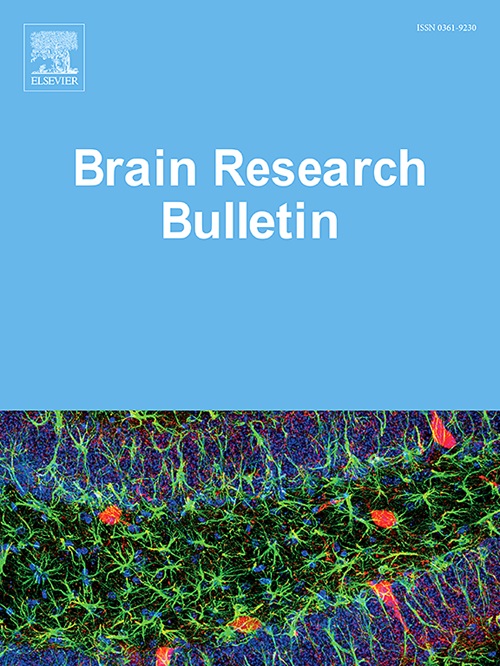IF 3.5
3区 医学
Q2 NEUROSCIENCES
引用次数: 0
摘要
背景:姜黄中的主要活性化合物双去甲氧基姜黄素(BDMC)具有多种药理特性。本研究旨在探讨 BDMC 对创伤性脑损伤(TBI)具有保护作用的机制:方法:采用费尼自由落体硬膜外撞击法建立大鼠创伤性脑损伤模型,然后进行 BDMC 治疗。将大鼠皮层神经元细胞暴露于过氧化氢(H2O2)以诱导氧化应激,然后用 BDMC 处理。同时还使用自噬抑制剂 3-MA 和热休克蛋白 90 alpha 家族 A 类成员 1(HSP90AA1)抑制剂 17-AAG 对细胞进行预处理。此外,实验还包括用 17-AAG 处理暴露于 H2O2 的皮层神经元并沉默 HSP90AA1 的表达。共免疫沉淀被用来验证 HSP90AA1 与转录因子 EB(TFEB)、TFEB 与核因子红细胞 2 相关因子 2(Nrf2)之间的相互作用,以及这些复合物在细胞质和细胞核中的定位:结果:BDMC 治疗可明显降低创伤性脑损伤大鼠的神经系统严重程度评分、脑含水量、炎症浸润、氧化应激和大脑皮层细胞凋亡。此外,BDMC 还能提高 Beclin 1 的表达和轻链 3(LC3)II/LC3 I 的比例,同时降低 p62 的表达。它还促进了 TFEB 的核转位,提高了细胞质和细胞核中 HSP90AA1 的水平,同时提高了 TBI 模型中核 Nrf2 的表达。体外实验表明,BDMC 处理后,丙二醛水平降低,谷胱甘肽过氧化物酶和超氧化物歧化酶水平升高,同时抑制了大脑皮层神经元的凋亡,提高了 Beclin 1 和 LC3 II/LC3 I 的表达,降低了 p62 的表达,减少了细胞质中 TFEB 的表达,提高了细胞核中 TFEB 和 Nrf2 的表达,提高了细胞质和细胞核中 HSP90AA1 的表达。从机理上讲,BDMC通过激活HSP90AA1/TFEB/Nrf2轴介导自噬和氧化应激。最后,在细胞模型中,HSP90AA1通过与TFEB结合来调节Nrf2的表达:结论:BDMC 通过 HSP90AA1 介导的 TFEB 核转位调节自噬和氧化应激,从而减轻了大鼠的创伤性脑损伤。本文章由计算机程序翻译,如有差异,请以英文原文为准。
Bisdemethoxycurcumin mitigates traumatic brain injury in rats by modulating autophagy and oxidative stress via heat shock protein 90 alpha family class A member 1-mediated nuclear translocation of transcription factor EB
Background
Bisdemethoxycurcumin (BDMC), the primary active compound found in turmeric, exhibits diverse pharmacological properties. The study aimed to investigate the mechanisms underlying the protective effects of BDMC in traumatic brain injury (TBI).
Methods
A rat TBI model was established using the Feeney’s freefall epidural impact method, followed by BDMC treatment. Rat cortical neuron cells were exposed to hydrogen peroxide (H2O2) to induce oxidative stress and then treated with BDMC. The cells were also pretreated with autophagy inhibitor 3-MA and heat shock protein 90 alpha family class A member 1 (HSP90AA1) inhibitor 17-AAG. Additionally, the experiments also involved treating H2O2-exposed cortical neurons with 17-AAG and silencing HSP90AA1 expression. Co-immunoprecipitation was utilized to verify interactions between HSP90AA1 and transcription factor EB (TFEB), TFEB and nuclear factor erythroid 2 related factor 2 (Nrf2), and the localization of these complexes in the cytoplasm and nucleus.
Results
BDMC treatment significantly reduced modified neurological severity scores, brain water content, inflammatory infiltration, oxidative stress, and apoptosis in the cerebral cortex of TBI rats. Additionally, BDMC treatment elevated the expression of Beclin 1 and light chain 3 (LC3) II/LC3 I ratio while decreasing p62 expression. It also promoted TFEB nuclear translocation and increased HSP90AA1 levels in both the cytoplasm and nucleus, along with elevated nuclear Nrf2 expressions in TBI models. In vitro experiments showed decreased malondialdehyde levels, elevated glutathione peroxidase and superoxide dismutase levels upon BDMC treatment, along with repressed cortical neurons apoptosis, elevated Beclin 1 and LC3 II/LC3 I expressions, decreased p62 expressions, reduced cytoplasmic TFEB expression, increased nuclear TFEB and Nrf2 expression, and elevated HSP90AA1 expression in the cytoplasm and nucleus. Mechanistically, BDMC mediated autophagy and oxidative stress by activating HSP90AA1/TFEB/Nrf2 axis. Finally, HSP90AA1 was shown to regulate Nrf2 expression by binding to TFEB in the cellular model.
Conclusions
BDMC alleviated TBI in rats by regulating autophagy and oxidative stress through HSP90AA1-mediated nuclear translocation of TFEB.
求助全文
通过发布文献求助,成功后即可免费获取论文全文。
去求助
来源期刊

Brain Research Bulletin
医学-神经科学
CiteScore
6.90
自引率
2.60%
发文量
253
审稿时长
67 days
期刊介绍:
The Brain Research Bulletin (BRB) aims to publish novel work that advances our knowledge of molecular and cellular mechanisms that underlie neural network properties associated with behavior, cognition and other brain functions during neurodevelopment and in the adult. Although clinical research is out of the Journal''s scope, the BRB also aims to publish translation research that provides insight into biological mechanisms and processes associated with neurodegeneration mechanisms, neurological diseases and neuropsychiatric disorders. The Journal is especially interested in research using novel methodologies, such as optogenetics, multielectrode array recordings and life imaging in wild-type and genetically-modified animal models, with the goal to advance our understanding of how neurons, glia and networks function in vivo.
 求助内容:
求助内容: 应助结果提醒方式:
应助结果提醒方式:


